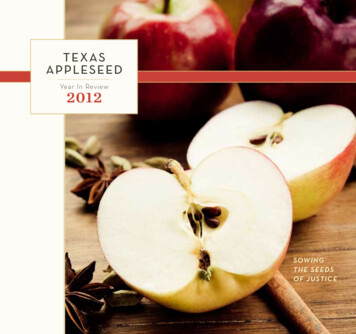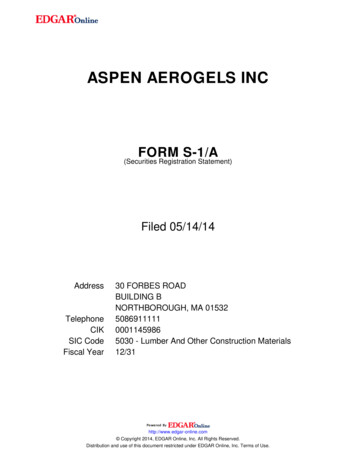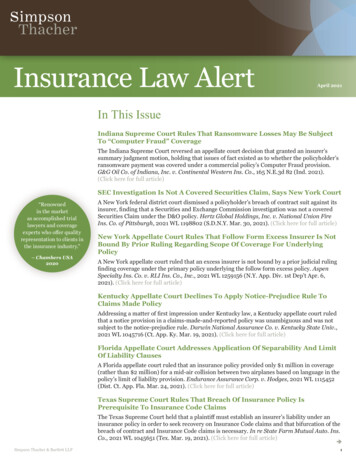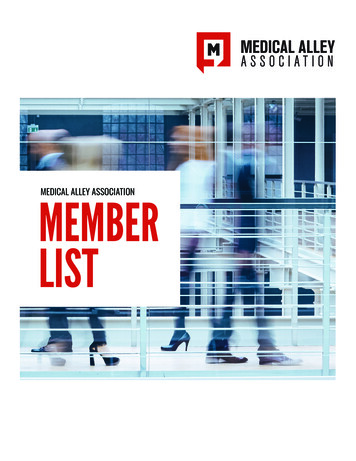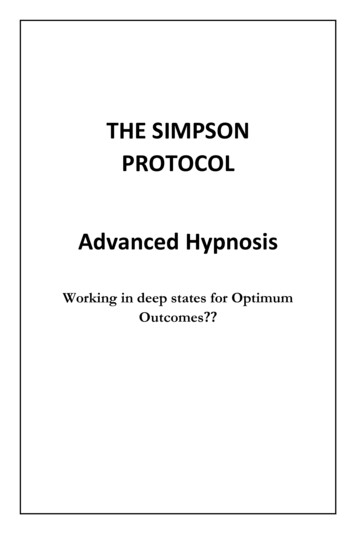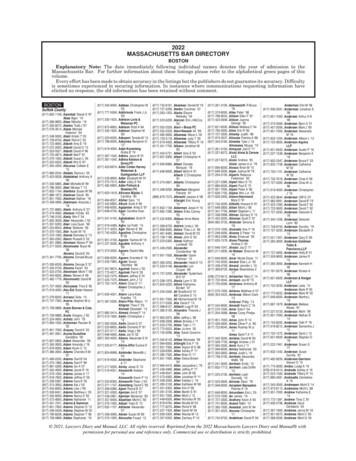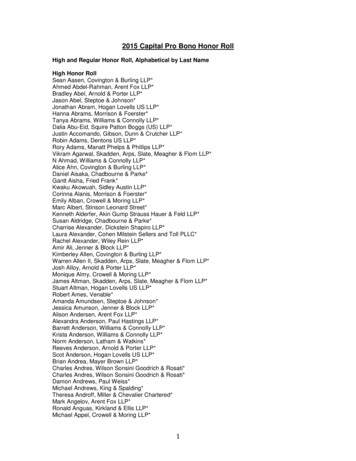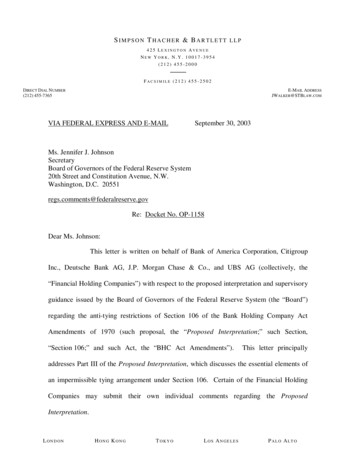
Transcription
SIMPSON THACHER & BAR TLETTLLP425 LE XINGTON AVE NUENEW Y OR K, N .Y . 10017 -3954(2 1 2 ) 4 5 5 -2 0 0 0FAC S IM ILE (212 ) 455 -2502DIRECT D IAL N UMBER(212) 455-7365E-MAIL ADDRESSJWALKER@STBLAW.COMVIA FEDERAL EXPRESS AND E-MAILSeptember 30, 2003Ms. Jennifer J. JohnsonSecretaryBoard of Governors of the Federal Reserve System20th Street and Constitution Avenue, N.W.Washington, D.C. 20551regs.comments@federalreserve.govRe: Docket No. OP-1158Dear Ms. Johnson:This letter is written on behalf of Bank of America Corporation, CitigroupInc., Deutsche Bank AG, J.P. Morgan Chase & Co., and UBS AG (collectively, the“Financial Holding Companies”) with respect to the proposed interpretation and supervisoryguidance issued by the Board of Governors of the Federal Reserve System (the “Board”)regarding the anti-tying restrictions of Section 106 of the Bank Holding Company ActAmendments of 1970 (such proposal, the “Proposed Interpretation;” such Section,“Section 106;” and such Act, the “BHC Act Amendments”).This letter principallyaddresses Part III of the Proposed Interpretation, which discusses the essential elements ofan impermissible tying arrangement under Section 106. Certain of the Financial HoldingCompanies may submit their own individual comments regarding the ProposedInterpretation.LON D ONH ON G K O N GTOKYOLO S AN GE LE SPAL O ALT O
Ms. Jennifer J. Johnson-2-September 30, 2003The Financial Holding Companies conclude for the reasons discussed in thisletter that (i) the Board is correct in its conclusion that the provisions of Section 106 applyonly to coercive tie-ins, and therefore a bank may violate Section 106 only if the bank forcesor coerces a customer to obtain (or provide) the tied product as a condition to obtaining thecustomer’s desired product, (ii) the Board is correct in its conclusion that Section 106 is anantitrust statute, (iii) the Board is correct in its conclusion that the coercion requirementunder Section 106 is the same as under the general antitrust laws, (iv) these conclusions ofthe Board necessarily lead to the conclusion that a bank must have economic power in thedesired-product market to violate Section 106, since economic power is a necessarycondition for coercion, and (v) consistent with each of these conclusions, the legislativehistory of the BHC Act Amendments makes clear that such economic power is a necessaryelement of an illegal tying arrangement under Section 106.Economic Power Paper. The Proposed Interpretation states in a footnote(note 21) that legislative history “indicates” that economic power is not a necessary elementof a Section 106 claim. The Board recognized in the Proposed Interpretation (at page 9)that economic power in the desired-product market is a necessary element of an illegal tyingarrangement under the provisions of the general antitrust laws that apply to sucharrangements -- Section 1 of the Sherman Act1 and Section 3 of the Clayton Act.2 Attachedto this letter is a paper entitled Economic Power and the Bank Tying Provisions, dated115 U.S.C. § 1.215 U.S.C. § 14.
Ms. Jennifer J. Johnson-3-September 30, 2003September 2003 (the “Economic Power Paper”), which concludes that economic power inthe market for the tying product (the desired product) is an essential element of an illegaltying arrangement under Section 106.This Economic Power Paper is the firstcomprehensive analysis of Section 106 of which the Financial Holding Companies areaware that begins with an examination of the treatment of tying arrangements under thegeneral antitrust laws and then analyzes the complete legislative history of the BHC ActAmendments with respect to the development of the provisions that were ultimately enactedas Section 106.The conclusion in the Economic Power Paper that economic power in thedesired-product market is an essential element of a violation of Section 106 is fully andfirmly supported by an understanding of the treatment of tying arrangements under thegeneral antitrust laws, which is required to understand the scope and requirements of Section106, and by a complete and careful reading of the very long legislative history of the BHCAct Amendments. The Financial Holding Companies strongly believe that the treatment oftying arrangements under the general antitrust laws, the decisions of the United StatesSupreme Court (the “Supreme Court”) and other courts regarding tying arrangements, thefull legislative history of the BHC Act Amendments, the language of Section 106, and theBoard’s correct conclusion in the Proposed Interpretation that Section 106 applies only tocoercive tie-ins all support the conclusion, and indeed dictate, that a bank must haveeconomic power in the desired-product market in order for a bank tie-in to violate Section106.
Ms. Jennifer J. Johnson-4-September 30, 2003While this conclusion regarding such economic power may be at odds withthe historical understanding of banking lawyers, certain courts and others, such historical“misunderstanding” should not be perpetuated. The Financial Holding Companies believethat the conclusions in a paper issued last week by the Office of the Comptroller of theCurrency (the “OCC”)3 are generally consistent with the conclusions set out in this letter andin the Economic Power Paper. While the OCC White Paper does not explicitly state that abank must have such economic power to violate Section 106, the OCC White Paper doesconclude that “Congress Intended [Section 106] to Prevent Anti-Competitive ConsequencesResulting From Improper Tying Arrangements”4 and that “Banks Do Not Possess theMarket Power [in the Commercial Loan Market] to Engage in Anti-Competitive Tying.”5The Financial Holding Companies believe that it necessarily follows from these twoconclusions that a bank must have economic power in the desired-product market to violateSection 106. The Financial Holding Companies respectfully submit that the conclusion thata bank must have such economic power to violate Section 106 should be reflected in theBoard’s final interpretation and supervisory guidance regarding the anti-tying restrictions ofSection 106.3Office of the Comptroller of the Currency, International and Economic AffairsDepartment and Law Department, Today’s Credit Markets, Relationship Banking,and Tying (Sept. 2003) (the “OCC White Paper”).4Id. at 21.5Id. at 7. The OCC White Paper states further that “banks [do not] appear to possessmarket power in lending to larger commercial customers that are the most likelytargets for tying. Pricing power in this market is a necessary condition for effectivetying by banks.” Id. at 30.
Ms. Jennifer J. Johnson-5-September 30, 2003It is clear that the Board, throughout the legislative process that led to theenactment of Section 106, understood (i) that the bank tying legislation would “prohibitbanks from engaging in coercive tying practices[,]” (ii) “that under present antitrust laws,such [coercive tying] practices are prohibited where the bank has sufficient market power[6]to force tie-ins on unwilling customers[,]” and (iii) that the bank tying legislation, if enacted,would not “materially alter existing law.”7 Elimination in the bank context of the wellestablished requirement of the general antitrust laws that the seller of the desired productmust have economic power in the desired-product market would have materially altered inthe bank context the then-existing antitrust laws. The Financial Holding Companies believethat at long last it should be recognized, understood and accepted that under Section 106,just as under the general antitrust laws, an essential element of an illegal tying arrangementis that a bank must have “sufficient market power to force tie-ins on unwilling customers.”This is true whether such market power is identified as a separate element of a Section 106violation (an approach that is fully consistent with the enactment of Section 106 as anantitrust statute) or is embedded within the proof of “coercion” element (an approach that isfully consistent with the Board’s interpretation of the coercion requirement).6The terms “market power” and “economic power” are synonymous and are usedinterchangeably in this letter.7Quoting One-Bank Holding Company Legislation of 1970: Hearings on S. 1052,S. 1211, S. 1664, S. 3823, and H.R. 6778 Before the Senate Comm. on Banking andCurrency, 91st Cong., 2d Sess. 136-37 (1970) (the “Senate Hearings”) (letter datedJune 1, 1970 from the Board to Senator Edward Brooke). See notes 96-98 below andthe accompanying text.
Ms. Jennifer J. JohnsonI.-6-September 30, 2003Section 106 Applies Only to Coercive Tie-InsIn the Proposed Interpretation, the Board states:[S]ection 106 applies only if each of two requirements are met: (1) acondition or requirement exists that ties the customer’s desired product toanother product; and (2) this condition or requirement was imposed or forcedon the customer by the bank. (Page 12; emphasis added.)[I]f a condition or requirement exists tying the customer’s desired product toanother product, a violation of section 106 may occur only if the condition orrequirement was imposed or forced on the customer by the bank. In thisregard, section 106 was intended to prohibit banks from using their ability tooffer bank products, and credit in particular, as leverage[8] to force acustomer to purchase (or provide) another product from (or to) the bank or anaffiliate. (Page 14; emphasis added.)Accordingly, if a condition or requirement exists, further inquiry maybe necessary to determine whether the condition or requirement was imposedor forced on the customer by the bank. If the condition or requirementresulted from coercion by the bank, then the condition or requirementviolates section 106, unless an exemption is available for the transaction.(Page 15; emphasis added.)After carefully reviewing the language, legislative history and purposes of thestatute, the Board believes that a violation [of section 106] may exist only if abank forces or coerces a customer to obtain (or provide) the tied product as acondition to obtaining the customer’s desired product. (Note 36; emphasisadded.)The Financial Holding Companies entirely agree with the conclusion of theBoard that the provisions of Section 106 apply only to coercive tie-ins. The language,legislative history and purposes of Section 106 make absolutely clear that a bank mayviolate Section 106 only if the bank forces or coerces a customer to obtain (or provide) thetied product as a condition to obtaining the customer’s desired product.8See note 56 below and the accompanying text.
Ms. Jennifer J. Johnson-7-September 30, 2003Beyond the legislative history cited by the Board in the ProposedInterpretation to support this conclusion (in notes 33-35), additional legislative history alsosupports this conclusion. Throughout the long legislative process that led to the enactmentof the BHC Act Amendments, Assistant Attorney General Richard McLaren, the head of theAntitrust Division of the Department of Justice, maintained the position that coercive tie-inswould be addressed by a specific provision in the proposed legislation -- which provisionwas enacted as Section 106 of the BHC Act Amendments -- and that the danger of voluntarytie-ins would be addressed by the Board in the context of acting on applications of bankholding companies to engage in nonbanking activities under another specific provision inthe proposed legislation -- which provision was enacted as Section 4(c)(8) of the BankHolding Company Act of 1956, as amended by the BHC Act Amendments(“Section 4(c)(8)”).99See, e.g., Bank Holding Company Act Amendments: Hearings on H.R. 6778 Beforethe House Comm. on Banking and Currency, 91st Cong., 1st Sess. 93-94, 485 (1969)(the “House Hearings”) (Apr. 17, 1969 proceedings, and Apr. 24, 1969proceedings); Senate Hearings at 269-70 (May 18, 1970 proceedings).It is important to recognize that in analyzing the danger of voluntary tie-ins in thecontext of Section 4(c)(8) applications, the premise of the Board’s analysis is that inthe absence of significant economic power in the desired-product market there canbe no danger of voluntary tie-ins. See, e.g., J.P. Morgan & Co. Inc., 68 Fed. Res.Bull. 514, 517 (1982) (“[V]oluntary tying can only take place when a firm possessessignificant market power.”); Citicorp, 67 Fed. Res. Bull. 443, 445-46 (1981);Mercantile Bancorporation, 66 Fed. Res. Bull. 799, 800 (1980); The AlabamaFinancial Group, Inc., 60 Fed. Res. Bull. 596, 602-603 (1974). There is noreasonable basis for such economic power to be a necessary element in the voluntarytie-in analysis under Section 4(c)(8) but not to be a necessary element in the coercivetie-in analysis under Section 106.
Ms. Jennifer J. Johnson-8-September 30, 2003This conclusion is also supported by case law. In Integon Life InsuranceCorp. v. Browning, the Eleventh Circuit Court of Appeals stated that “a tying claim underthe [BHC Act Amendments] has two elements: (1) two separate products, a ‘tying’ or‘desirable’ product and a ‘tied’ or ‘undesirable’ product; and (2) the buyer was in fact forcedto buy the tied product to get the tying product; that is, a ‘tying’.”10As the Board noted in the Proposed Interpretation (in note 36), the FifthCircuit Court of Appeals stated in Dibidale of Louisiana, Inc. v. American Bank & TrustCo.11 that Section 106 was intended to apply to tying arrangements whether or not thearrangements were coerced.In support of this statement, the court quoted from theConference Report on the BHC Act Amendments.12 While the language quoted by the courtdoes state that the BHC Act Amendments were intended to address coercive as well asvoluntary tie-ins, it is clear from a reading of the language in context that, with respect tovoluntary tie-ins, Congress intended that they would be addressed under Section 4(c)(8), asamended by the BHC Act Amendments, rather than under Section 106 of the BHC ActAmendments. In fact, the Conference Report language quoted by the court in Dibidale isimmediately followed by the following statement: “Section 106 of the bill, which hasbecome known as the anti-tie-in section, will largely prevent coercive tie-ins. . . .”13 The10989 F.2d 1143, 1150 (11th Cir. 1993) (emphasis added).11916 F.2d 300 (5th Cir. 1990), amended and reinstated, 941 F.2d 308 (5th Cir. 1991).12Conf. Rep. No. 91-1747 (1970) (the “Conference Report”).13Conference Report at 18.
Ms. Jennifer J. Johnson-9-September 30, 2003dissenting opinion in Dibidale strongly disagreed with the Dibidale majority opinion,concluding that “the plain meaning of the statute, its similarity to the anti-tying provisions ofthe federal antitrust laws, and the history of its drafting all clearly indicate that a tyingarrangement must be forced upon an unwilling party to constitute a violation.”14 TheEleventh Circuit in Integon Life Insurance Corp. agreed with this conclusion of thedissenting opinion in Dibidale.15For the reasons discussed in the Proposed Interpretation and in this letter, theFinancial Holding Companies believe that the Board is correct in its conclusion that theprovisions of Section 106 apply only to coercive tie-ins, and therefore a bank may violateSection 106 only if the bank forces or coerces a customer to obtain (or provide) the tiedproduct as a condition to obtaining the customer’s desired product.II.Section 106 Is an Antitrust StatuteThe Board stated in the Proposed Interpretation (at page 9) that “Congressmodeled section 106 on the anti-tying principles developed under the general antitrust laws(the Sherman and Clayton Acts). . . .” Section 106 is “intended to provide specific statutoryassurance that the use of the economic power of a bank will not lead to a lessening ofcompetition or unfair competitive practices.”16 Section 106 is designed “to prohibit anti-14Dibidale, 916 F.2d at 308 (dissenting opinion).15Integon Life Insurance Corp., 989 F.2d at 1150, 1151 n.20.16Quoting S. Rep. No. 91-1084 (1970) (the “Senate Report”), at 3.
Ms. Jennifer J. Johnson-10-September 30, 2003competitive practices. . . .”17 In introducing H.R. 6778,18 the first of a number of bills thatare part of the legislative history of the BHC Act Amendments, Representative WrightPatman stated that among the important issues involved in the proposed legislation is“[w]hether additional antitrust safeguards such as prohibitions against tie-in arrangements”should be enacted.19 One Senator stated that the provisions of proposed legislation that wereultimately enacted as Section 106 are an “explicit statement of the present status of antitrustpolicy as it applies to banks.”20The Seventh Circuit Court of Appeals has stated that Section 106 proscribes“arrangements that traditionally have been targets of the antitrust laws because of theirpotentially anticompetitive effects.”21 The Eighth Circuit Court of Appeals has stated thatthe anti-tying restrictions of the Home Owners’ Loan Act,22 which are applicable to savingsassociations and “are virtually identical to those applicable to banks under Section 106[,]”2317Quoting the Senate Report at 17. See also Continental Bank of Pennsylvania v.Barclay Riding Academy, Inc., 93 N.J. 153, 167, cert. denied, 464 U.S. 994 (1983)(Practices “are violative of the Act [Section 106] only if they are anti-competitive.”).18H.R. 6778, 91st Cong., 1st Sess. (Feb. 17, 1969).19House Hearings at 3 (Apr. 15, 1969 proceedings).20116 Cong. Rec. S15701 (daily ed. Sept. 16, 1970) (statement of Sen. Gary Hart).Senator Hart stated further that such provisions are an “explicit congressionaldefinition of antitrust policy in this area.” Id.21Davis v. First National Bank of Westville, 868 F.2d 206, 208 (7th Cir.), cert. denied,493 U.S. 816 (1984).2212 U.S.C. § 1464(q).23Quoting the Proposed Interpretation (at page 8).
Ms. Jennifer J. Johnson-11-September 30, 2003“are antitrust restraints specific to the field of commercial banking and therefore must beapplied in a manner consistent with Sherman Act and Clayton Act principles.”24 Anothercourt has stated that Section 106 “is not a general regulatory provision. . . .”25The conclusion that Section 106 is an antitrust statute is further supported bythe provisions of Section 106(c) of the BHC Act Amendments,26 which provide that theDepartment of Justice may institute proceedings in equity to prevent and restrain violationsof Section 106, and by the provisions of Section 106(e) of the BHC Act Amendments,27which provide that any person injured in its business or property by reason of a violation ofSection 106 may bring a civil action for damages and shall be entitled to recover three timesthe amount of the damages (“treble damages”)28 and the cost of the suit. These are the same24Rayman v. American Charter Federal Savings & Loan Assn., 75 F.3d 349, 356 (8thCir. 1996).25Freidco of Wilmington, Delaware, Ltd. v. Farmers Bank of the State of Delaware,499 F. Supp. 995 (D. Del. 1980).2612 U.S.C. § 1973.2712 U.S.C. § 1975.28A plaintiff under Section 106, like a plaintiff under the general antitrust laws, mustprove injury to the plaintiff, must prove that the injury was a direct consequence ofthe antitrust violation, and must demonstrate that the extent of the injury isdeterminable and not speculative. See, e.g., Campbell v. Wells Fargo Bank, N.A.,781 F.2d 440, 443, rehearing denied, 784 F.2d 1113 (5th Cir.), cert. denied, 476 U.S.1159 (1986), applying Walker v. U-Haul of Mississippi, 747 F.2d 1011, 1014 (5thCir. 1984). If a bank does not have economic power in the desired-product market, aplaintiff would not be able to prove any injury that is caused by a tying arrangement.As discussed in this letter and in the Economic Power Paper, it has been widelyrecognized that absent such economic power tying cannot conceivably have anyadverse impact. Therefore, the fact that Congress provided such a remedy in Section106(e) of the BHC Act Amendments supports the conclusion that Congress intended
Ms. Jennifer J. Johnson-12-September 30, 2003enforcement procedures and remedies as under the Sherman Act and the Clayton Act.29 Oneantitrust scholar has stated: “Few legal rules are more firmly rooted in history than trebledamages recovery for victims of antitrust violations.”30Clearly, Section 106 is an antitrust statute that addresses the same anticompetitive practices that are addressed by Section 1 of the Sherman Act and Section 3 ofthe Clayton Act. Section 106 does not address concerns outside the competitive sphere,such as concerns regarding inequitable or unfair practices, consumer protection, interestrates and other loan terms, unsafe and unsound banking practices, or concerns raised in otherregulatory contexts.31Other laws, for example Sections 23A and 23B of the FederalReserve Act, as amended, address such other concerns.that a bank must have economic power in the desired-product market for a tyingarrangement to violate Section 106. Proof of the existence of economic power in thedesired-product market is a central element to the proof of injury under Section106(e). It follows that such economic power must be established to prove a violationof Section 106 itself since it would be illogical for Congress to create a statutoryscheme whereby arrangements that violate the substantive provisions of the schemecould not cause any injury to the persons the scheme is designed to protect.29Under Section 4 of the Sherman Act (15 U.S.C. § 4), the Department of Justice,acting through the Antitrust Division, has exclusive federal governmental authorityto enforce the Sherman Act, and under Section 15 of the Clayton Act (15 U.S.C.§ 25), the Department of Justice has authority to enforce the Clayton Act. Section 4of the Clayton Act (15 U.S.C. § 15(a)) provides for such treble damages forviolations of Section 1 of the Sherman Act and Section 3 of the Clayton Act.30Herbert Hovenkamp, Economics and Federal Antitrust Law § 15.6, at 404 (1985).31One commentator has stated:[T]he consumer protection concerns raised by tie-ins involvesignificantly different issues than those raised by potentiallyanticompetitive ties. Different explanations of tying practices are
Ms. Jennifer J. Johnson-13-September 30, 2003Accordingly, the Financial Holding Companies believe that the Board iscorrect in its conclusion that Section 106 is an antitrust statute.III.The Coercion Requirement Under Section 106 Is the Same As Under theGeneral Antitrust LawsThe Proposed Interpretation makes clear that the coercion requirement underSection 106 is the same as under the provisions of the general antitrust laws that addressesillegal tying arrangements -- Section 1 of the Sherman Act and Section 3 of the Clayton Act.The Board stated in the Proposed Interpretation (at page 11) that the “[bank-imposedcondition or requirement] element of section 106 was modeled on the tying prohibitions inthe general antitrust laws.”The Board stated in the Proposed Interpretation (at pages 11-12; emphasis inoriginal) that “a seller engages in an illegal tie under the general antitrust laws only if itrequires the customer to purchase the tied product to obtain the customer’s desired product.Moreover, the evidence must demonstrate that the seller imposed the arrangement throughsome type of coercion.” The Board cited (in note 27) numerous cases under the generalantitrust laws to the effect that “actual coercion” is an indispensable element of a tyingviolation under the general antitrust laws, and the Board concluded (at page 12) that thisactual coercion element “also is embedded in section 106.”involved; different evidence is needed to test the various explanations;and different legal remedies are likely to be appropriate if a problemis found to exist.Richard Craswell, Tying Requirements in Competitive Markets:Protection Issues, 62 Boston U.L. Rev. 661, 700 (1982).The Consumer
Ms. Jennifer J. Johnson-14-September 30, 2003The Financial Holding Companies agree with the Board’s analysis andconclusions that under both the general antitrust laws and Section 106 a condition orrequirement must be imposed by a seller on a customer through actual coercion or force toconstitute an illegal tying arrangement, and that such coercion requirement under Section106 is the same as under the general antitrust laws.IV.Economic Power Is a Necessary Condition for CoercionAs stated above, the Proposed Interpretation states in a footnote (note 21)that legislative history “indicates” that economic power is not a necessary element of aSection 106 claim. As discussed in detail below and in the Economic Power Paper, theFinancial Holding Companies conclude, based on an understanding of antitrustjurisprudence and an extensive analysis of the legislative history of the BHC ActAmendments, that a bank must have economic power in the desired-product market toviolate Section 106. The Financial Holding Companies believe that the Board’s conclusions(i) that a violation of Section 106 may occur only if a bank forces or coerces a customer toobtain (or provide) a tied product as a condition to obtaining the customer’s desired product,(ii) that Section 106 is an antitrust statute and (iii) that the coercion requirement underSection 106 is the same as under the general antitrust laws necessarily lead to the conclusionthat a bank must have economic power in the desired-product market to violate Section 106.As a matter of common sense and logic, which is reflected in the case law, ifa seller does not have economic power with respect to the desired product, a tyingarrangement cannot be imposed, forced or coerced. Power is a necessary condition for
Ms. Jennifer J. Johnson-15-September 30, 2003coercion, and economic power is a necessary condition for an anti-competitive tyingarrangement. The Supreme Court stated in Jefferson Parish Hospital District No. 2 v. Hyde:Our cases have concluded that the essential characteristic of an invalid tyingarrangement lies in the seller’s exploitation of its control over the tyingproduct to force the buyer into the purchase of a tied product that the buyereither did not want at all, or might have preferred to purchase elsewhere ondifferent terms.Accordingly, we have condemned tying arrangements when the seller hassome special ability -- usually called “market power” -- to force a customer todo something that he would not do in a competitive market.Only if [buyers] are forced to purchase [seller’s] services as a result of the[seller’s] market power would the arrangement have anticompetitiveconsequences.32The OCC has very recently stated: “Coercive ties . . . are premised on the bank’s power tocontrol the situation.”33This general principle reflects the common English language meaning of“coerce” -- “to compel to an act or choice” and “to enforce or bring about by force orthreat.”34 Without power, threatening conduct is not credible and can achieve no objectiveand thus the threatening party will stand only to lose the goodwill, respect and business of itscustomer.32446 U.S. 2, 12, 13-14, 25 (1984) (emphasis added). The Supreme Court’s decisionin Jefferson Parish Hospital is replete with “forcing of buyers” language; it is clearfrom the context of the opinion that such language is used to refer to the need toshow that the defendant had economic power in the desired-product market.33OCC White Paper at 19.34Webster’s New Collegiate Dictionary (1979).
Ms. Jennifer J. Johnson-16-September 30, 2003The Board cited in the Proposed Interpretation (in notes 25 and 27)numerous cases under the general antitrust laws to support its conclusion that proof ofcoercion is a required element of an illegal tying arrangement. Importantly, in virtuallyevery such case, coercion was explicitly linked to proof of the seller’s economic power inthe desired-product market. Thompson v. Multi-List, Inc.35 is among these cited cases.There, the Eleventh Circuit concluded that economic power is a necessary condition forcoercion. The court stated:In order to prove the economic coercion prong of the tying analysis, theplaintiffs must prove that Metro [the defendant] has “sufficient marketpower,” Tix-X-Press, 815 F.2d at 1420, within the tying market and thatMetro has wielded its market power to force brokers to “buy a product that[they do] not want or would have preferred to buy elsewhere on other terms.”Id. at 1416.The plaintiffs first must prove that Metro has sufficient market powerwithin the relevant product market to coerce. . . .***To satisfy the coercion element of the claim, the plaintiffs need toshow that Metro not only has this market power but also has wielded thismarket power to force brokers to alter their choice. . . .36The Thompson court makes explicitly clear that the existence of economic power and thewielding of such power are necessary conditions for coercion.The court logicallyconcluded that to prove coercion a plaintiff must prove that the seller has economic power in35934 F.2d 1566 (11th Cir. 1991), reh’g en banc denied, 946 F.2d 906 (1991), cert.denied, 506 U.S. 903 (1992).36Id. at 1576, 1577.
Ms. Jennifer J. Johnson-17-September 30, 2003the desired-product market and that the seller has wielded such economic power to force thebuyer to purchase the tied product.Both the Eleventh Circuit in Thompson and the Board in the ProposedInterpretation (in notes 26 and 27) cited Tic-X-Press, Inc. v. Omni Promotions Co.37 withrespect to the coercion element of an illegal tying arrangement. In Tic-X-Press, the EleventhCircuit stated:The key element to such [a tying] arrangement’s anticompetitiveness (andthus its illegality) is the seller’s ability to force buyers to purchase oneproduct in the package, the tied product, by virtue of the seller’s control ordominance over the other product in the package, the tying [or desired]product.38This court makes clear that “[t]he key element to . . . a [tying] arrangement’s . . .illegality . . . is the seller’s ability to force . . . by virtue of the seller’s control
SIMPSON THACHER & BARTLETT LLP 425 LE X INGTON AVEN UE NEW YORK, N.Y. 10017-3954 (212) 455-2000 FACS IM ILE (212) 455-2502 DIRECT DIAL NUMBER E-MAIL ADDRESS (212) 455-7365 JWALKER@STBLAW.COM VIA FEDERAL EXPRESS AND E-MAIL September 30, 2003 Ms. Jennifer J. Johnson Secretary Board of Governors of the Federal Reserve System
